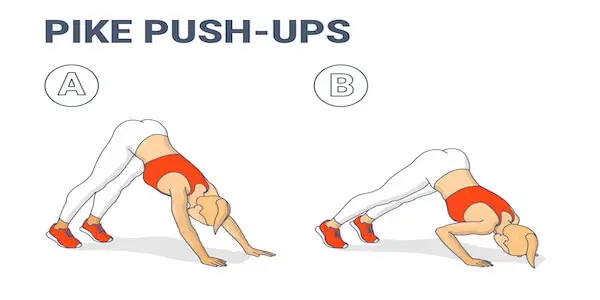Are you looking to improve your upper body strength? Pike push-ups can help you achieve this goal.
Basically, this move is a variation of the traditional push-up and targets the shoulders, chest, and triceps. It is a bit more challenging than a regular push-up, so start with smaller reps and work your way up as you get stronger.
In today’s blog post, we will discuss how to do pike push-ups correctly, as well as some of the benefits they offer.
Psst. We have plenty of variations for every fitness level too.
Let’s get started.
Table of Contents
How to Do Pike Push-Ups
Pike-push-ups are just inverted overhead presses using your body weight. As such, they will test your shoulders to a new extreme. Let’s see how they’re done:
The Beginner’s Option
One variation is the one above, as you can see explained in the video:
- Start in a regular push-up position with your hands shoulder-width apart and your feet hip-width apart.
- Then, keeping your core engaged, raise your hips so that your body forms an upside-down V shape.
- From there, lower your head and upper body toward the floor diagonally.
- Then press back up to the starting position.
Note how your arms, legs, and the floor creates a triangle shape.
Also, you will bend your elbows so your head is lowered diagonally to the ground, not perpendicular to it.
Pro tip: For an even lower strength level, we have plenty of options in the final section below.
The Intermediate Option
The intermediate option, as seen in this video, teaches you to:
- Start in an all-fours position, with your hands just outside shoulder width.
- Your hips and knees should be aligned.
- Lift your butt without moving your arms.
- Bend your elbows, bringing your head further in front of you until your forehead touches the ground. Then come back up.
- Keep your back straight throughout this motion, and remember to move diagonally in front, not straight down.
Although coach Jake Gay claims this is the beginner version, it’s actually much harder than the one above.
The Difficult Option
For this pike push-up, you will have to:
- Begin in a straight, upright position.
- Lower your hands until they reach the ground.
- Take your feet back behind you until they form a 45-degree angle with your upper body.
- Bend your elbows and push your head down diagonally until your forehead greets the floor.
Want to make things heavier?
Elevate your legs on a plyo box or a coffee table.
Muscles Worked
Pike push-ups work your:
- Anterior deltoids
- Chest muscles (pectoralis major and minor)
- Triceps
- Rib muscles
- Lower back
- Hamstrings
Here’s how:
The anterior deltoids are located at the front of your shoulders. They are the muscles that give your shoulder its round shape.
Doing a pike push-up puts more pressure on these muscles than on your chest compared to a traditional push-up.
Your chest muscles and triceps will get a good workout, too, though.
But unlike a traditional push-up, your rib muscles (serratus anterior and inferior) will be activated more intensely. That’s because when you pike up, your ribs flare out.
Your lower back and hamstrings also work hard to stabilize your body in this position.
Therefore, you could say doing pike push-ups works is a total body exercise (to a certain extent).
Benefits of Pike Push-Ups

Pike push-ups offer many benefits, including:
- Improved shoulder mobility: The overhead position of the pike push-up stretches the front of the shoulder (anterior deltoid) and improves its range of motion.
- Greater muscle activation: As we mentioned, pike push-ups target the anterior deltoids more than traditional push-ups. They also activate the serratus anterior and triceps to a greater degree.
- Improved posture: The pike position is excellent for improving posture because it strengthens the muscles that support good posture. As your shoulders and upper back become stronger, you won’t feel the need to hunch forward. Besides, your stronger glutes and the lumbar area will help keep your back straight throughout the day instead of arching your hips forward.
How to Incorporate Pike Push-Ups Into Your Workout
Pike push-ups are a great exercise to include in your upper body workouts. Here are a few ways you can incorporate them into your routine:
- As the main lift: You can use pike push-ups as your primary upper body exercise. After that, you can use your arms mostly for cardio (e.g., jumping jacks or punches).
- As a superset: You can pair pike push-ups with another upper body exercise such as pull-ups or dips. For example, you could do a set of pike push-ups followed by a set of pull-ups.
- As a finisher: You can use pike push-ups to top off your upper body workout with an intense exercise. For example, you could try twenty pike push-ups after completing your upper body strength routine.
Pike Push-Up Variations
Here are a few variations of pike push-ups that you can try:
- Elevated pike push-ups: Place your feet on a high surface, such as a chair or bench. This position will make the exercise harder because your shoulders will have to lift more weight.
- Plyometric pike push-ups: Explosively push off the ground and clap your hands between each rep.
- Knee pike push-ups: Get into the pike position and place your knees on the ground. This variation is easier for beginners.
- Yoga block pike push-ups: Place your hands on yoga blocks instead of the ground to take the pressure off of your shoulders a bit more.
- Standing pike push-up on a nearby wall: Try to recreate the triangle position, supporting your arms on the wall in front of you. Your legs should be straight on the floor. Then, bend your elbows so your head gets pushed diagonally to the wall.
As you can see, there’s always a pike push-up variation you can try, regardless of your fitness level.
So give them a try and see how they can help you build upper body strength.
Do you want to build stronger shoulders? Read this article about the best gym machines for shoulders. You’ll also find some good ones to consider for home use.
- What Happens To Your Body When You Do Dips Every Day - June 28, 2024
- 9 Push-Up Mistakes You Might Be Making (And How to Fix Them) - October 10, 2022
- The Complete Guide to Mastering Upper Chest Push Ups - October 10, 2022

